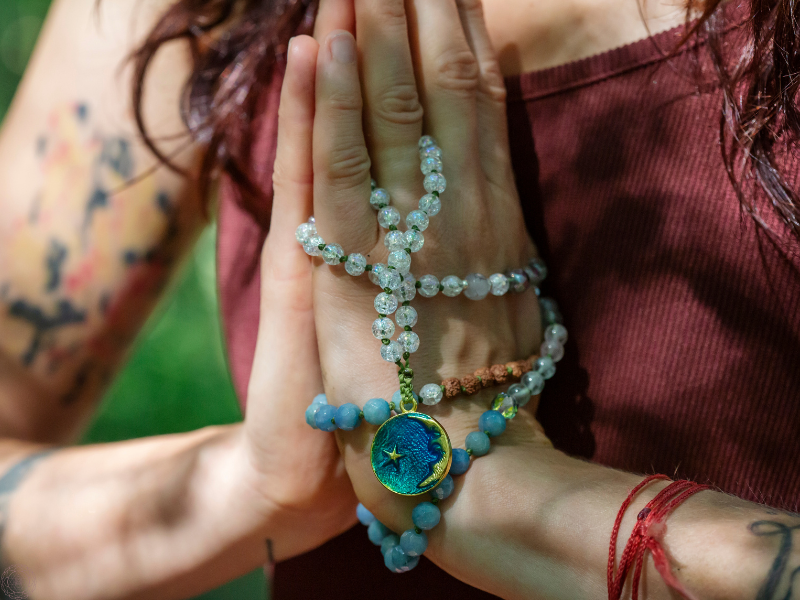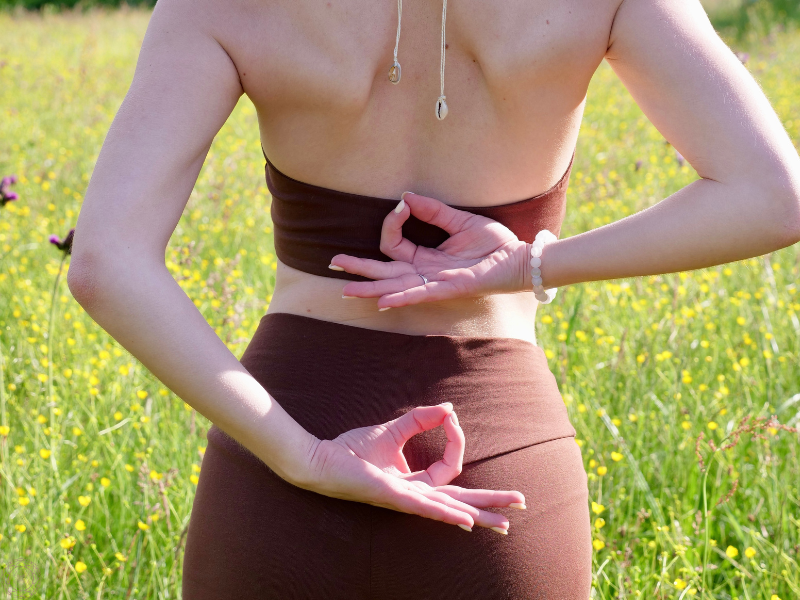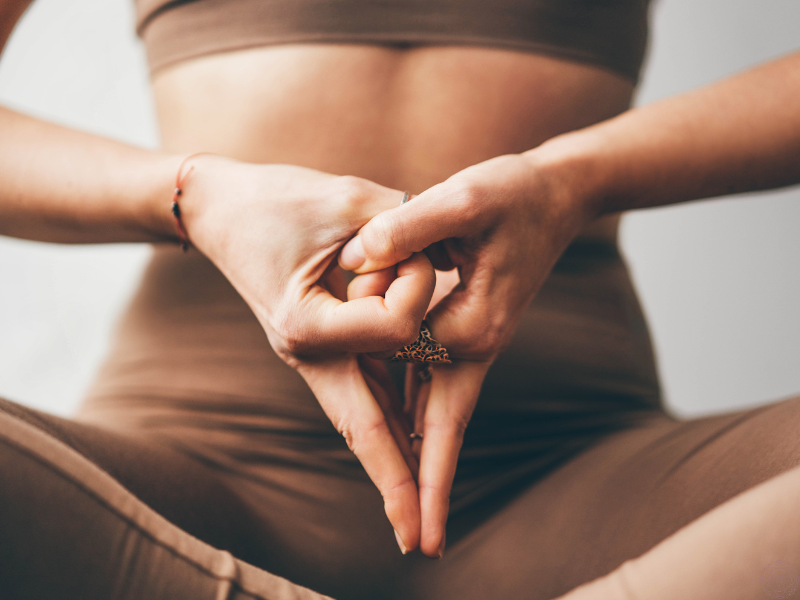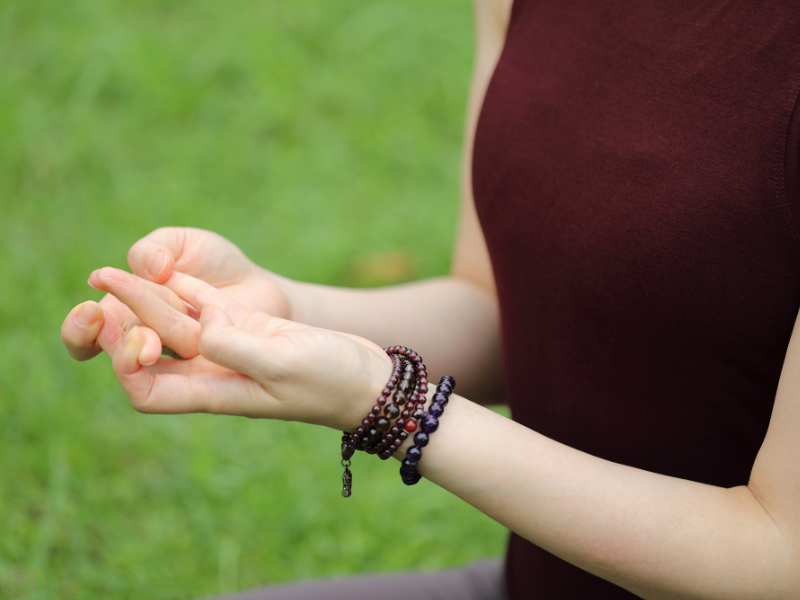Across ancient spiritual traditions, you’ll find a quiet yet powerful practice that requires no tools, words, or complex rituals- only your hands. These gestures, known as mudras, are sacred symbols of energy, intention, and awareness. They serve as bridges between the physical and the subtle realms, guiding prana- your life force- into balance and harmony.
In this guide, you’ll discover what mudras are, their spiritual and energetic significance, how they work within yoga and meditation, and how to incorporate them into your daily sadhana.
Understanding Mudras: The Language of Energy
The word mudra comes from Sanskrit and can be translated as “seal,” “gesture,” or “symbol.” In spiritual traditions like yoga and tantra, mudras represent a form of energetic communication. Each gesture directs prana, or vital energy, to specific parts of the body or energy centers known as chakras.
Just as language uses sound to convey meaning, mudras use physical form to express spiritual intention. When you bring your fingers and hands into certain positions, you create energetic circuits that affect both the body and the mind.
Mudras are often used during meditation, pranayama (breathwork), mantra chanting, or as part of ritual practice. They help deepen focus, awaken consciousness, and align your inner energies.

The Origins of Mudras
The practice of mudras dates back thousands of years. Ancient yogic texts, such as the Hatha Yoga Pradipika and Gheranda Samhita, mention mudras as tools for awakening kundalini shakti– the dormant spiritual energy at the base of the spine.
You can also find depictions of mudras in Hindu art. Statues of deities and yogis often display distinct hand positions. Each gesture tells a story or expresses a spiritual truth- like fearlessness, compassion, or wisdom.
In tantric philosophy, mudras are seen as powerful symbols that unite the microcosm (individual consciousness) with the macrocosm (universal consciousness).
How Mudras Work
From a yogic perspective, your hands are extensions of your subtle energy body. Each fingertip corresponds to one of the five elements- earth, water, fire, air, and ether. When you touch or press certain fingers together, you influence these elemental forces within yourself.
Here’s a quick overview of the five elements and their connection to the fingers:
- Thumb: Fire (Agni)
- Index Finger: Air (Vayu)
- Middle Finger: Ether or Space (Akasha)
- Ring Finger: Earth (Prithvi)
- Little Finger: Water (Jala)
By joining different fingers, you balance these elements, restoring harmony to your physical, emotional, and energetic systems.
A mudra may involve the entire body through a combination of asana (posture), pranayama (breath control), bandha (energy locks), and visualization techniques. Or, it can be as simple as the graceful position of the hands during meditation.
Classical yogic texts such as the Hatha Yoga Pradipika describe mudras as subtle expressions of awareness. They are typically introduced only after one has gained some proficiency in asana, pranayama, and bandha- once the major energetic blockages have been cleared.
The Energetic Science of Mudras
At their core, mudras manipulate prana in much the same way that light reflects off a mirror or sound bounces back from a cliff face. The nadis (energy channels) and chakras (energy centers) constantly radiate prana, which typically escapes into the external world.
When we form a mudra, we create energetic barriers or seals within the body. This prevents the outward dissipation of prana and redirects it inward. Over time, this internalization of energy awakens deeper awareness and strengthens our connection to the subtle body.
Mudras also activate neural pathways in the brain. The hands contain dense networks of nerve endings. When you form a mudra, you stimulate these pathways, which can calm the nervous system, enhance focus, and influence emotional states.
In short, mudras are both energetic and neurological tools for transformation.
A Practice Passed Down Through Lineage
While references to mudras appear in many ancient texts, they were traditionally transmitted directly from guru to disciple. The reason is simple: mudras are not just physical exercises but energetic keys, and their true effects unfold only through correct guidance and experience.
Because of their power to awaken prana, chakras, and even kundalini, these practices were considered sacred and often kept secret, revealed only when a student was ready to handle their effects responsibly.
The Spiritual Purpose of Mudras
At their core, mudras help you channel awareness. They are a form of embodied meditation- where your physical posture supports your spiritual state.
When you hold a mudra during meditation or breathwork, your mind begins to follow your body’s cues. Over time, this creates a steady state of inner peace and heightened awareness.
Mudras also work on a subtle energetic level by influencing the flow of prana through the nadis– the body’s energy channels. By sealing or redirecting this energy, mudras allow practitioners to conserve vitality and awaken higher states of consciousness.

Types of Mudras in Yogic and Tantric Traditions
Mudras are not limited to the hands. In yogic and tantric systems, they can also involve the eyes, body, or even the mind. However, hasta mudras (hand gestures) are the most well-known and accessible form.
Here are the main types of mudras used in yogic traditions:
1. Hasta Mudras (Hand Gestures)
These are gestures made with the fingers and hands to balance energy and focus the mind. They are commonly practiced during meditation and pranayama.
Examples Include:
- Jana mudra
- Chin mudra
- Yoni mudra
- Bhairava mudra
- Hridaya mudra
2. Mana Mudras (Head Gestures)
These involve the eyes, tongue, lips, and facial expressions. For example, Shambhavi Mudra– the gaze between the eyebrows- helps direct awareness inward.
Examples Include
- Shambhavi mudra
- Nasikagara drishti
- Khechari mudra
- Kaki mudra
- Bhujangini mudra
3. Kaya Mudras (Postural Gestures)
These include full-body gestures or poses combined with concentration that influence pranic flow.
Examples Include:
- Vipareeta karani mudra
- Manduki mudra
- Tadagi mudra
- Pashinee mudra
4. Bandha Mudras (Locks)
These use muscular contractions or “locks” to control energy flow. These practices combine mudra and bandha.
Examples Include:
- Maha mudra
- Maha bheda mudra
- Maha vedha mudra
5. Adhara Mudras (Perineal Gestures)
These mudras involve the pelvic floor area and are often used in advanced tantric or kundalini practices.
Examples Include:
- Ashwini mudra
- Vajroli/ sahajoli mudra
Each category has its purpose, but all share one common thread: directing energy with intention and awareness.

10 Common Mudras and Their Meanings
Below are some of the most powerful and widely practiced hand mudras.
1. Gyan Mudra (Mudra of Knowledge)
How to do it: Touch the tip of your thumb to the tip of your index finger. Keep the other three fingers straight.
Benefits: Enhances concentration, stimulates wisdom, and promotes calmness. It’s often used in meditation to balance the air element and reduce restlessness.
2. Chin Mudra (Gesture of Consciousness)
How to do it: Same as Gyan Mudra, but palms face upward on the knees.
Benefits: Awakens spiritual awareness and connects the individual self to the universal self.
3. Anjali Mudra (Gesture of Reverence)
How to do it: Bring your palms together at your heart center. Press your thumbs lightly against your sternum, keep your fingers pointed upward.
Benefits: Cultivates gratitude, humility, and balance between the left and right hemispheres of the brain. Commonly used in yoga as a gesture of respect.
4. Dhyana Mudra (Meditation Gesture)
How to do it: Place the right hand over the left, palms facing upward, thumbs touching lightly.
Benefits: Encourages deep meditation and inner stillness. Symbolizes unity and the path toward enlightenment.
5. Prana Mudra (Gesture of Life Force)
How to do it: Touch the tips of your ring and little fingers to the thumb. Keep other fingers straight.
Benefits: Activates dormant energy and strengthens the immune system. Often used to increase vitality.
6. Apana Mudra (Gesture of Detoxification)
How to do it: Touch the tips of your middle and ring fingers to the thumb.
Benefits: Aids elimination and detoxification. Balances downward-moving energy, promoting grounding.
7. Surya Mudra (Gesture of the Sun)
How to do it: Fold your ring finger and press it down with your thumb.
Benefits: Stimulates the fire element, increases metabolism, and promotes warmth and vitality.
8. Varun Mudra (Gesture of Water)
How to do it: Touch the tip of your little finger to your thumb.
Benefits: Improves hydration and skin health. Balances the water element in the body.
9. Shuni Mudra (Gesture of Patience)
How to do it: Touch the tip of the middle finger to the thumb.
Benefits: Encourages discipline, patience, and stability. Enhances intuition and insight.
10. Hridaya Mudra (Heart Gesture)
How to do it: Fold your index finger so that its tip touches the base of your thumb. Touch the tips of your thumb, middle, and ring finger together. Extend your little finger outward. Rest your hands on your knees, palms facing outward.
Benefits: Opens the heart center, relieves emotional pain, and promotes compassion.
Mudras and the Chakras
Each mudra corresponds to specific energy centers or chakras. For example:
- Gyan Mudra aligns with the Ajna (Third Eye) chakra, enhancing intuition.
- Anjali Mudra harmonizes the Anahata (Heart) chakra.
- Surya Mudra stimulates the Manipura (Solar Plexus) chakra.
- Apana Mudra grounds energy through the Muladhara (Root) chakra.
By combining mudras with chakra-focused meditation, you can deepen your energetic awareness and spiritual connection.
How to Practice Mudras
Practicing mudras is simple yet profound. You can practice them anywhere- during meditation, yoga, or even while sitting quietly.
Here’s how to get started:
- Choose a Mudra: Begin with one that aligns with your intention- like Gyan Mudra for focus or Hridaya Mudra for compassion.
- Find a Comfortable Position: Sit in a relaxed posture, such as Sukhasana (Easy Pose) or on a chair with your spine straight.
- Hold the Gesture: Form the mudra with both hands and rest them gently on your thighs or in your lap.
- Breathe Deeply: Focus on your breath. Let it become slow and rhythmic.
- Meditate: Maintain the mudra for 5–15 minutes. With time, you can increase to 30 minutes.
The key is consistency. Practicing daily helps you tune into subtle shifts in your body and mind.
Integrating Mudras Into Daily Life
You don’t need to limit mudras to formal meditation sessions. You can integrate them into your daily routine effortlessly.
- Morning: Start your day with Surya Mudra to awaken vitality.
- Work Breaks: Use Gyan Mudra to restore focus and clarity.
- Evening: Practice Hridaya Mudra or Varun Mudra to calm your mind and nurture emotional balance before sleep.
Even a few minutes can shift your energy and restore balance to your system.

The Subtle Effects of Mudra Practice
Over time, consistent practice of mudras refines your energy. You may notice greater emotional stability, deeper meditation, and enhanced awareness of subtle sensations in the body.
Spiritually, mudras serve as doorways to higher states of consciousness. They remind you that sacredness isn’t found outside you- it’s expressed through your own hands, breath, and awareness.
Awaken Energy Through Sacred Gesture
In essence, mudras are far more than symbolic gestures. They are living technologies of energy- tools that harmonize the inner and outer worlds, seal the vital currents within, and redirect them toward spiritual awakening.
Through each gesture, you awaken prana, deepen mindfulness, and remember your innate power to direct life force intentionally.
When practiced with awareness and devotion, mudras become a shortcut to stillness, a seal of sacred energy, and a bridge between the human and the Divine.
This post was all about mudras.
Other Posts You May Like:
Hi love!
I’m a Nutritional Therapy Practitioner and Dharmic Healer looking to guide you back to your true Self through various mind, body, and spirit healing modalities.
I’m Rana.
LEARN MORE
Leave a Reply Cancel reply
Rana is a Nutritional Therapy Practitioner and Dharmic Healer here to guide you back to your true Self through various mind, body, and spirit healing modalities.
HOME
ABOUT
CONTACT
BLOG
SHOP
OFFERINGS
© Mantras and Mulberries.